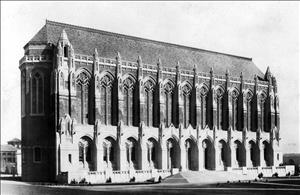This essay contains the Seattle historian and photographer Paul Dorpat's Now & Then photographs and reflections on the University of Washington's Suzzallo Library, designed by Bebb and Gould and opened in the winter of 1927.
Now & Then -- Suzzallo Library
In the autumn of 1933, the University of Washington Board of Regents named the library after former University President Henry Suzzallo, who had just died. The library, dubbed "Cathedral of Books," had opened to students seven years earlier, in the winter of 1927.
The name signified not only the building's gothic lines, but also the spiritual qualities evoked by the design. As President Suzzallo observed, "The library is the soul of the University."
With this thought in mind, the architects, Bebb and Gould, designed a cathedral less for books than for looking up from books. In the Tudor-style reading room, the ceiling, looming 73 feet above the floor, invited gazing (lofty daydreams?). It was the most edifying study hall this side of Oxford. At the time, The Seattle Times reported, "it is pronounced by experts to be the most beautiful reading room on the continent, and is ranked among the most beautiful in the world."
Lighted by the rose and yellow-ochre light of 36-foot-high stained glass windows, 240-feet-long with a quiet floor of compressed cork, the reading room's only bookshelves lined the outer walls below the windows. This very large, significant space was indeed the soul of the university.
A decade before it was named after him, the library was identified with Henry Suzzallo. The man who would eventually fire him, Governor Roland Hartley, characterized the proposed library as "Suzzallo's extravagance." Hartley disliked both intellectuals and the university, and tried to withhold all tax support from the school. When a Suzzallo-led lobby overrode the governor's veto, he was so enraged that after attacking Suzzallo's nationality, his salary of $18,000 a year, and his library, he had him sacked by a specially-appointed board of regents.
In 1932 Hartley, failing re-election, was sacked by the voters, and one year later Suzzallo's name was put above the door of his soulful extravagance.
In the historical setting ,the Suzzallo Library stands magnificently alone. We see it through a screen of poplars whose shadows repeat the line of the paths that cross the spacious lawn. That green lawn is still remembered by a few hundred thousand alumni.
In 1969, a big hole was dug here and the results are both seen and unseen in the contemporary scene. Hidden below is a 1000-car garage whose considerable carbon monoxide fumes are drawn out a 140-foot smokestack disguised as a brick monolith. Here it casts its shadow on the library.
Above, where there was grass, is now the red-tiled expanse officially named the Suzzallo Quadrangle, but almost always called Red Square. This popular name may have been inevitable, but its choice was helped along by Cassandra Amesely, news editor of the university newspaper, The Daily. Given a class assignment in propaganda, she decided, "My project would be to get the students to refer to it as Red Square." And, of course, she managed the news and the name.
Whether fronted by green grass or red tile, Suzzallo's "Cathedral of Books" still has its big room inside, and there one can still look up from a book and visualize the soul of the university.

